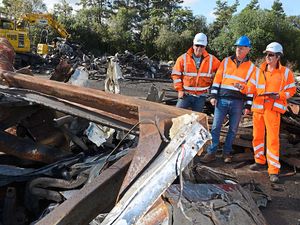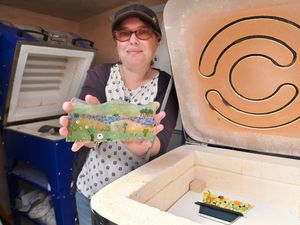Former Shropshire scrap yard going back to nature - with video
A former Shropshire car scrap yard is slowly being transformed into a nature reserve.

Rising from the lakes of oil, mountains of tyres and tonnes of rubbish is a cleared area of land which in the coming months will hopefully welcome hundreds of visitors.
Work at the former Furber’s car scrap yard in Whixall is being carried out by specialist firms, employed by Shropshire Wildlife Trust.
Asbestos is being carefully removed, tanks of oil dismantled and drained and and buildings torn down. Earlier this year thousands of tyres were removed
The latest contract has been won by waste management specialist, Intowaste, which removed tens of thousands of tyres from the site earlier this year. The scrapyard is itself part-designated as a special area of conservation because it sits on top of two metres of deep peat.
In the final phase, they will be removing an accumulation of waste from dismantled cars, plastic and several tumbledown buildings.
Hazardous
It is part of a major project to restore habitats on and around Whixall Moss, which is internationally important for its wildlife. Cleaning up the scrapyard, which closed recently after 50 years in business, forms part of a project to restore several areas of Fenns, Whixall, Bettisfield and Wem Mosses that has received grants from the European Union LIFE fund and Heritage Lottery Fund.
Gary Grantham, the remediation co-ordinator for Shropshire Wildlife Trust is in charge of the work. He said: “We had the opportunity to purchase the site. Natural England manage Fenns Whixall and Bettisfield Moss but parts had been damaged around the edges by this yard.
“We received a grant from the EU LIFE Fund and we used some of the grant and some funds we raised ourselves to acquire the site. Money was made available to clean it up and the first phase was to remove 60,000 tyres and that cost in the region of £90,000.
See also:
“The phase we have entered now will cost around £250,000-£300,000 and this is the main phase of the clearance. There is a lot of hazardous waste such as asbestos and oil tanks that we have to remove. We are working with Intowaste to do this as well as City Environmental and it should be finished by the end of October.
“It is not just on the surface that we are having to work, there is also oil contamination below the ground. Oil has seeped into the peat, which has soaked it up so we are having to work to make that safe.” Another company working on site is Chemserve. They have been contracted to remove all of the other waste, some of which has been very time consuming. Tyres have to be separated before they can be reused and the majority are being shredded and used as fuel in cement kilns. “Nothing of this scale has been done in north Shropshire before,” said Gary.
The final decision on how the site will be used once the clean-up operation is complete is yet to be made. Initial plans for a visitor’s centre and cafe appear to have been shelved although the Wildlife Trust is exploring the possibilities of an ‘interpretation’ site complete with information boards telling visitors of the major work which has been done to return the site to its original state.
“We are looking at making the site more accessible to the public and attract them to come along. There would be a visitor reception area and a very simple interpretation area which would tell the story of the scrap yard and the peat bog. Part of it will be re-turfed to allow people to get out on to the moss itself.”
The project, which also aims to restore swamp, fen, willow and alder carr wet woodland missing from the edge of the bog, will then provide homes for willow and marsh tit and rare bog wildlife.




